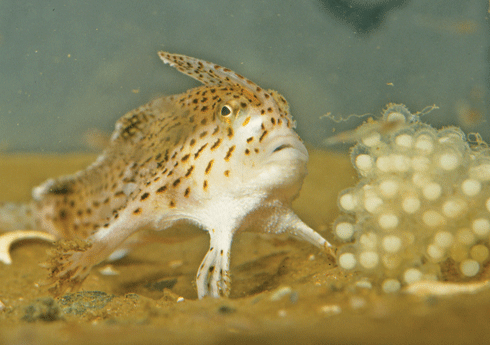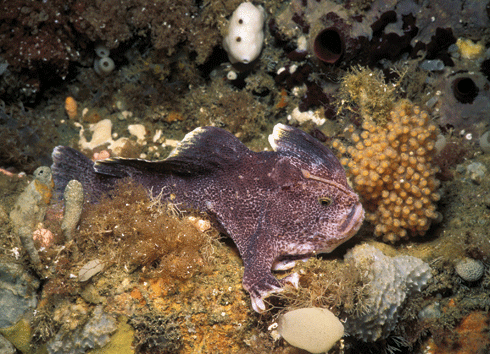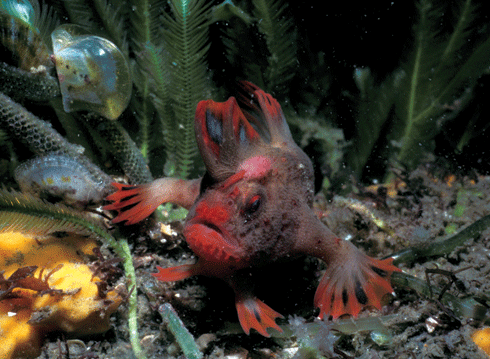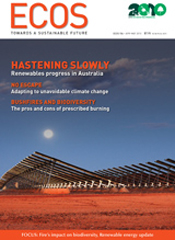
|
Published:
Handfishes: thylacines of the sea?
A taxonomic review has added nine species to a curious group of fishes that once walked the world, and raised an urgent need for their conservation.

|
|
Handfishes are extremely vulnerable to environmental change. Credit: CSIRO
|
In December 2008, ichthyologists at the CSIRO Australian National Fish Collection (ANFC) in Hobart received a unique package from the Muséum national d’Histoire naturelle in Paris.
Their reverential unwrapping revealed a tiny, wrinkled, creamy-yellow fish, with hand-like front fins and the bearing of a bullfrog.
It was one of the first Australian fishes discovered by science: the only known specimen of the smooth handfish and one of three handfishes collected -in 1802 during a French expedition led by Captain Nicolas Baudin.
The smooth handfish was on loan to Peter Last and Daniel Gledhill for a review by the CSIRO Wealth from Oceans Flagship that would add nine species and three genera to the handfish family, and heighten concerns about their conservation.
Handfishes are small, often colourful or patterned, benthic fishes that tend to ‘walk’ on hand-like pectoral fins rather than swim. They exist only on the seabeds of southern and eastern Australia, with most species endemic to Tasmania.
‘Handfishes have provided an ongoing curiosity for artists and natural historians, particularly in the 19th century,’ says ANFC curator, Peter Last.
‘Despite this interest, and conservation concerns for some species, classification of handfishes has been confused, largely due to their rarity and a lack of specimens.’
Gledhill says handfishes are extremely vulnerable to environmental change – pest species, pollution, siltation, fishing, rising sea temperatures and coastal development – due to their scarcity, patchy distribution, low breeding rates and poor dispersal capabilities.
Conservation concerns so far have focused on the spotted handfish which is listed as endangered under the Environment Protection and Biodiversity Conservation Act 1999 (EPBC Act).
Spotted handfish live on sandy substrates and lay egg clusters that attach to the bottom in bundles. After hatching, the young hover around the clutch. With no larval phase, they have little opportunity to disperse and colonise new areas. Once present from Hobart to north-eastern Tasmania, they now are restricted to isolated populations in the Derwent River and nearby bays.
The CSIRO review of the handfishes has raised concerns about the decline of at least two more handfish species, the red handfish and Ziebell’s handfish, and exposed a paucity of information about the abundance, distribution and biology of the broader handfish family.

|
|
Ziebell’s handfish exists in isolated populations off eastern and southern Tasmania. Populations of several handfish species are disappearing quickly. Credit: Karen Gowlett-Holmes
|
‘After reviewing all available information for handfishes, the situation appears to be dire for some species,’ Last says.
‘These truly iconic Tasmanian species are at risk of becoming “thylacines of the sea”. Conservation strategies need to be developed and implemented urgently if we want to reduce this risk.’
The scientists spent many months among preserved handfishes for the review, applying a mix of intuition, stringent technique and forensic inquiry.
‘It’s a long and intricate process involving much grouping and regrouping ... these guys all have a longer caudal fin ... maybe they’re all males, or females? You need to try and get a feel for the significance of such variations,’ Gledhill says.
They also examined scientific and historical references to handfishes and their classification, and discovered similarities between a handfish from the Great Australian Bight and a 50-million-year-old fossil at the Pesciara Cave deposits at Monte Bolca in Northern Italy.
‘Our theory is that handfishes were once fairly widespread but patchily distributed, before being subjected to broad scale extinction events, possibly in the Tertiary period,’ Last says.
‘The Australian region appears to have provided refuge to a remnant fauna that has since radiated locally. Thus the handfishes are of great importance to unlocking the history of Australia’s marine biota.’
Despite their extensive investigations, Last and Gledhill failed to find any immediate relatives for the smooth handfish, which returned to France an orphan.
‘For the time being that means this guy is unique, and is still only known from that original specimen collected in 1802. Despite Baudin using fairly primitive collection gear in limited depths, we haven’t encountered any more,’ Gledhill says.
‘It is unknown to science, other than from that one specimen, which I find is pretty amazing.’




